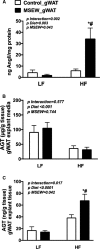Female Mice Exposed to Postnatal Neglect Display Angiotensin II-Dependent Obesity-Induced Hypertension
- PMID: 31752639
- PMCID: PMC6912962
- DOI: 10.1161/JAHA.119.012309
Female Mice Exposed to Postnatal Neglect Display Angiotensin II-Dependent Obesity-Induced Hypertension
Abstract
Background We have previously reported that female mice exposed to maternal separation and early weaning (MSEW), a model of early life stress, show exacerbated diet-induced obesity associated with hypertension. The goal of this study was to test whether MSEW promotes angiotensin II-dependent hypertension via activation of the renin-angiotensin system in adipose tissue. Methods and Results MSEW was achieved by daily separations from the dam and weaning at postnatal day 17, while normally reared controls were weaned at postnatal day 21. Female controls and MSEW weanlings were placed on a low-fat diet (LF, 10% kcal from fat) or high-fat diet (HF, 60% kcal from fat) for 20 weeks. MSEW did not change mean arterial pressure in LF-fed mice but increased it in HF-fed mice compared with controls (P<0.05). In MSEW mice fed a HF, angiotensin II concentration in plasma and adipose tissue was elevated compared with controls (P<0.05). In addition, angiotensinogen concentration was increased solely in adipose tissue from MSEW mice (P<0.05), while angiotensin-converting enzyme protein expression and activity were similar between groups. Chronic enalapril treatment (2.5 mg/kg per day, drinking water, 7 days) reduced mean arterial pressure in both groups of mice fed a HF (P<0.05) and abolished the differences due to MSEW. Acute angiotensin II-induced increases in mean arterial pressure (10 μg/kg SC) were attenuated in untreated MSEW HF-fed mice compared to controls (P<0.05); however, this response was similar between groups in enalapril-treated mice. Conclusions The upregulation of angiotensinogen and angiotensin II in adipose tissue could be an important mechanism by which female MSEW mice fed a HF develop hypertension.
Keywords: adipose tissue; hypertension; maternal separation; obesity; renin‐angiotensin system.
Figures





Similar articles
-
Obese Male Mice Exposed to Early Life Stress Display Sympathetic Activation and Hypertension Independent of Circulating Angiotensin II.J Am Heart Assoc. 2024 Jan 2;13(1):e029511. doi: 10.1161/JAHA.123.029511. Epub 2023 Dec 29. J Am Heart Assoc. 2024. PMID: 38156515 Free PMC article.
-
A model of neglect during postnatal life heightens obesity-induced hypertension and is linked to a greater metabolic compromise in female mice.Int J Obes (Lond). 2018 Jul;42(7):1354-1365. doi: 10.1038/s41366-018-0035-z. Epub 2018 Feb 23. Int J Obes (Lond). 2018. PMID: 29535450 Free PMC article.
-
Exacerbated obesogenic response in female mice exposed to early life stress is linked to fat depot-specific upregulation of leptin protein expression.Am J Physiol Endocrinol Metab. 2020 Nov 1;319(5):E852-E862. doi: 10.1152/ajpendo.00243.2020. Epub 2020 Aug 24. Am J Physiol Endocrinol Metab. 2020. PMID: 32830551 Free PMC article.
-
Early life stress exacerbates obesity in adult female mice via mineralocorticoid receptor-dependent increases in adipocyte triglyceride and glycerol content.Life Sci. 2022 Sep 1;304:120718. doi: 10.1016/j.lfs.2022.120718. Epub 2022 Jun 15. Life Sci. 2022. PMID: 35714704 Free PMC article.
-
The adipose-tissue renin-angiotensin-aldosterone system: role in the metabolic syndrome?Int J Biochem Cell Biol. 2003 Jun;35(6):807-25. doi: 10.1016/s1357-2725(02)00311-4. Int J Biochem Cell Biol. 2003. PMID: 12676168 Review.
Cited by
-
Methods for Modeling Early Life Stress in Rodents.Methods Mol Biol. 2025;2868:205-219. doi: 10.1007/978-1-0716-4200-9_11. Methods Mol Biol. 2025. PMID: 39546232 Review.
-
Intrarenal Renin Angiotensin System Imbalance During Postnatal Life Is Associated With Increased Microvascular Density in the Mature Kidney.Front Physiol. 2020 Sep 1;11:1046. doi: 10.3389/fphys.2020.01046. eCollection 2020. Front Physiol. 2020. PMID: 32982785 Free PMC article.
-
Epididymal Fat-Derived Sympathoexcitatory Signals Exacerbate Neurogenic Hypertension in Obese Male Mice Exposed to Early Life Stress.Hypertension. 2021 Nov;78(5):1434-1449. doi: 10.1161/HYPERTENSIONAHA.121.17298. Epub 2021 Oct 4. Hypertension. 2021. PMID: 34601958 Free PMC article.
-
Obese Male Mice Exposed to Early Life Stress Display Sympathetic Activation and Hypertension Independent of Circulating Angiotensin II.J Am Heart Assoc. 2024 Jan 2;13(1):e029511. doi: 10.1161/JAHA.123.029511. Epub 2023 Dec 29. J Am Heart Assoc. 2024. PMID: 38156515 Free PMC article.
-
Involvement of the Renin-Angiotensin System in Stress: State of the Art and Research Perspectives.Curr Neuropharmacol. 2022;20(6):1212-1228. doi: 10.2174/1570159X19666210719142300. Curr Neuropharmacol. 2022. PMID: 34554902 Free PMC article. Review.
References
-
- Centers for Disease Control and Prevention . Overweight and obesity. U.S. Department of Health & Human Services; 2018. Available at: http://www.cdc.gov/obesity/data.
-
- Sorof J, Daniels S. Obesity hypertension in children: a problem of epidemic proportions. Hypertension. 2002;40:441–447. - PubMed
-
- Flegal KM, Carroll MD, Ogden CL, Curtin LR. Prevalence and trends in obesity among us adults, 1999–2008. JAMA. 2010;303:235–241. - PubMed
-
- Lurbe E, Torro I, Aguilar F, Alvarez J, Alcon J, Pascual JM, Redon J. Added impact of obesity and insulin resistance in nocturnal blood pressure elevation in children and adolescents. Hypertension. 2008;51:635–641. - PubMed
-
- Wilsgaard T, Schirmer H, Arnesen E. Impact of body weight on blood pressure with a focus on sex differences: the Tromso Study, 1986–1995. Arch Intern Med. 2000;160:2847–2853. - PubMed
Publication types
MeSH terms
Substances
Grants and funding
LinkOut - more resources
Full Text Sources
Medical
Research Materials
Miscellaneous

